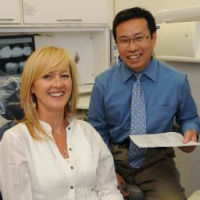Moxley, a Pioneer in Muscular Dystrophy Research and Care, to Step Down
Richard (Dick) Moxley III, M.D., one of the founding fathers of the URMC Department of Neurology and an important member of the CTSI community, is retiring after a career spanning more than four decades. Moxley, who holds the Helen Aresty Fine and Irving Fine Professorship in Neurology, is widely recognized for helping revolutionize our understanding of muscular dystrophy and the care of patients with this disease.
Upon his arrival in Rochester, Moxley helped start a Muscular Dystrophy Association-funded program focused on Duchenne muscular dystrophy, a childhood disease found primarily in boys. He was later part of a team that established the National Registry for Myotonic Dystrophy and Facioscapulohumeral Dystrophy, two of the most common forms of muscular dystrophy in adults, which now includes more than 2,200 people with these conditions.
The national registry has been an invaluable research tool that has enabled researchers across the county to study these diseases and recruit participants for clinical trials. In 2002, Moxley and his research partner, Charles Thornton, M.D., were the first to discover how a genetic flaw in individuals with the myotonic dystrophy (DM) interferes with important functions in muscle and other cells with help from the registry.
Moxley has also been a passionate advocate of patient-centered care, collaborating with former CTSI KL2 Career Development Awardee Chad Heatwole, M.D., and others to address the common disconnect between physicians and DM patients about which symptoms are most important to measure and treat. The team developed tools to help physicians and researchers determine which symptoms have the greatest impact on the quality patients’ lives and how to meaningfully measure the effectiveness of new treatments.
Moxley and Thornton also received supplemental funding from the CTSI to identify biomarkers of DM type 1. These efforts have brought scientists to the threshold of a new therapy that could reverse the genetic cause of this disease. Partnering with Isis Pharmaceuticals, the Rochester team developed a synthetic molecule – called an antisense oligonucleotide – that mimics a segment of the genetic code. In a study appearing in the journal Nature in 2012, the team showed that, when injected into mice with DM, these molecules improved function. Isis Pharmaceuticals has recently completed Phase 1 testing and will soon advance to testing in people with the disease.
Moxley was once the associate director, then director of the Clinical Research Center, a CTSI-affiliated resource for researchers conducting clinical trials at URMC, and also co-directed the CTSI’s Pilot Studies Program.
In 1989 trustee E. Philip Saunders began supporting Moxley's research after meeting him during a hospital visit. In 2011, Saunders continued his support for neurological disease research and established two professorships in neuromuscular research at URMC. At that time he also made significant donations to cancer research and the CTSI, helping to build the Medical Center’s Saunders Building, which houses the CTSI and is named in his honor.
Moxley will officially retire on July 1, 2017 but intends to continue to stay active in DM research by advising the National Institute of Arthritis and Musculoskeletal and Skin Diseases and the Myotonic Dystrophy Foundation, which recently honored Moxley and Thornton with their Outstanding Research Achievement Award. The Department of Neurology is planning a celebration of his career to be held in May 2018.
Michael Hazard | 6/8/2017



